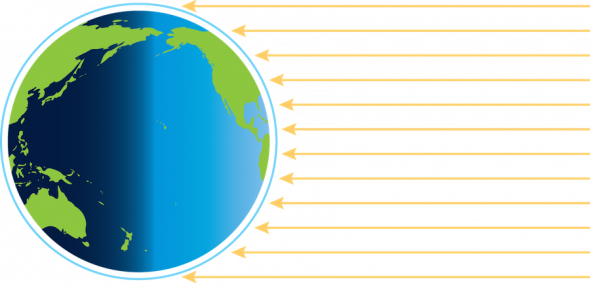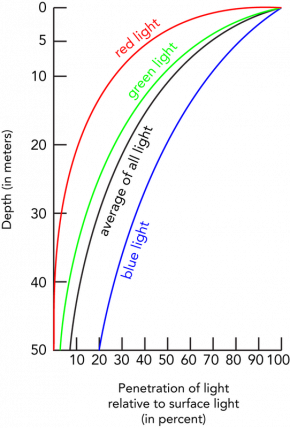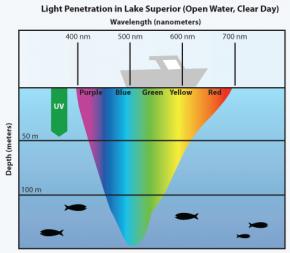Light Zones
Fig. 2.42. Light penetration decreases with water depth in the ocean. In the euphotic zone light intensity supports high levels of photosynthesis. In the disphotic zone light intensity allows vision but only low levels of photosynthesis. In the aphotic zone, sunlight is virtually absent, but there can be light production from organisms (bioluminescence).
Sunlight is the primary source of energy for photosynthesis. Algae and vascular plants that live in the water must live close enough to the surface to receive sunlight. The euphotic zone is the layer of water in which there is enough light for net photosynthesis. In other words, the rate of photosynthesis is faster than the rate of respiration (Fig. 2.42). There is an overall net production of oxygen in the euphotic zone.
In clear tropical waters, the euphotic zone may extend to a depth of 80 meters (m). Closer to the poles, sunlight energy does not penetrate as deeply. Thus, the euphotic zone may be less than 10 m deep (Fig. 2.42). In turbid waters, suspended material blocks light so that even less light can penetrate. Very muddy waters may have a euphotic zone of only a few centimeters.
The disphotic zone is the layer below the euphotic zone. This layer is also known as the twilight zone. In this zone, there is enough light for visual predators to see, and even for some photosynthesis. Howver, the rate of respiration in the disphotic zone is greater than the rate of photosynthesis. In clear water, the disphotic zone may extend as deep as 800 m. The euphotic and the disphotic zones together make up the photic zone.
Most of the ocean’s biomass lives in the photic zone. However, most of the ocean’s water lies beneath the photic zone—in the region called the aphotic zone. The aphotic zone begins where less than one percent of sunlight reaches. The aphotic zone is therefore very dark. In fact, light produced by bioluminescent organisms is more abundant than sunlight. Bioluminescence is the production and emission of light by a living organism. Bioluminescent light is produced through chemical reactions.
Aphotic zones are not restricted to ocean waters. Some lakes are also deep enough to have an aphotic zone. Lake Baikal in Russia, for example, is over 1600 m deep and has a large aphotic zone.
Table 2.9. Parts of words related to ocean light zones
| photo – light. For example, a photocopier uses light to make copies. |
| eu – good. For example, someone who is euphoric feels exceptionally good. |
| dis – removal of. For example, to disconnect is to remove a connection. |
| a – without. For example, someone who is amoral is without morals. |
Image caption
Fig. 2.43. From the equator to the poles, the sun’s rays meet Earth at smaller and smaller angles.
Image copyright and source
Fig. 2.44. The penetration of sunlight decreases rapidly with depth. Blue wavelengths of light penetrate the farthest, and red light penetrates the least.
The amount of energy that penetrates the surface of the water depends on the angle at which the sunlight strikes the ocean. When sunlight energy hits the ocean, some of it reflects off the surface and goes back into the atmosphere. Because the Earth is a sphere, only areas near the equator at midday come close to being perpendicular to the path of incoming light. Everywhere else, the light comes in at an angle (Fig. 2.43). Thus, a larger amount of energy penetrates the waters’ surface at the equator than at polar latitudes.
In addition to reflection, energy from the sun is lost to absorption (Fig. 2.44). In fact, water absorbs nearly all the relatively low-energy infrared wavelengths coming from sunlight within 0.1 m (10 centimeters) of the surface. In this very shallow layer, energy is converted to heat, which either raises the water temperature or causes water to evaporate.
Fig. 2.45. Visible colors of light penetrate differently into the ocean depths, as seen in this image depicting light penetration in Lake Superior. Longer wavelengths such as red are absorbed at a shallower depth than shorter wavelengths such as blue, which penetrate to a deeper depth.
Most swimmers have experienced warm surface water with much cooler water just beneath it. When wind and waves stir the surface waters, heat is transferred to cooler layers below. The thermocline is the place where water temperature changes abruptly from warmer to colder.
Visible light is the portion of the spectrum important in photosynthesis. Similar to infrared light, visible light is reflected and absorbed by the water. Within the first 10 m, more than 50 percent of the visible light energy is absorbed. Even in clear tropical water, only about one percent of visible light penetrates to 100 m (about 300 feet).
Lower energy red light is absorbed more quickly than higher-energy blue light. Even at a relatively shallow depth of 30 m, water has absorbed nearly all the visible light colors except blues. Thus both the intensity (amount) and the color of visible light vary with depth in the euphotic zone (Fig. 2.45). At 30 m depth, a scuba diver without a flashlight sees mostly in shades of blue. To see a full spectrum of colors, a diver must shine a flashlight.
See more information about light zones in the topic, Light in the Ocean.












